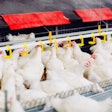
Scientists at the Roslin Institute have developed a three-dimensional tissue culture that will be used to study poultry gut biology.
“Our novel comprehensive poultry mini-gut model will give scientists a detailed view of how the intestines grow and respond to their environment. Previously there have been very few poultry-specific in vitro cell models, which has limited research in this essential field of gut health,” Tessa Nash, Roslin Institute, explained.
A good model for research
The mini-gut, also known as an enteroid, is inside-out when compared to the chicken intestine, with the internal surface on the exterior. This makes it easier for researchers to expose the tissue to the pathogens that can cause infection or disease.
It will support research on infections such as Salmonella and avian influenza, and the testing of promising feed additives, vaccines and drugs.
The enteroids, which contain several of the cell types found in chicken intestines, could reduce the number of animals needed for research.
“The global trend to reduce animal trials has resulted in an urgent need to develop comprehensive lab models whose results can be easily extrapolated to a living animal,” said Lonneke Vervelde, Personal Chair of Veterinary Immunology & Infectious Diseases at the Roslin Institute.
“Our poultry mini-guts provide a more robust tool than classical mammalian cell lines, thereby potentially reducing the costs of product development and reducing the number of chickens used for research.”
Specific growing conditions required
Previously, researchers have struggled to develop a chicken mini-gut model.
Enteroids require very specific growing conditions. Mammal-specific models typically grow in a protein-rich gel dome that contains a growth factor-supplemented liquid cell culture.
However, the chicken organoid required different conditions, preferring to flow in the liquid cell culture only.
“The chicken enteroid model does not flourish in the conditions established for mammalian enteroids so we needed to think outside the box. We performed a lot of experiments trialing different scaffolds and growth factors alongside a whole variety of other variables before we developed the final crypt/villus isolation and scaffold-less enteroid culture protocols,” Nash added.
Like what you just read? Sign up now for free to receive the Poultry Future Newsletter.

















